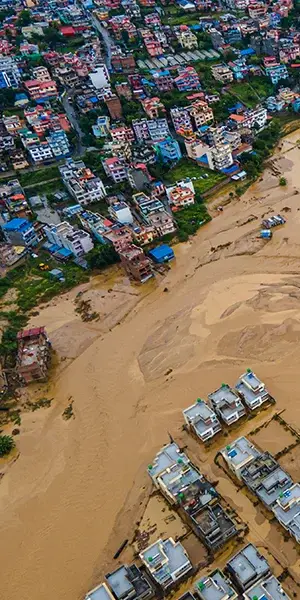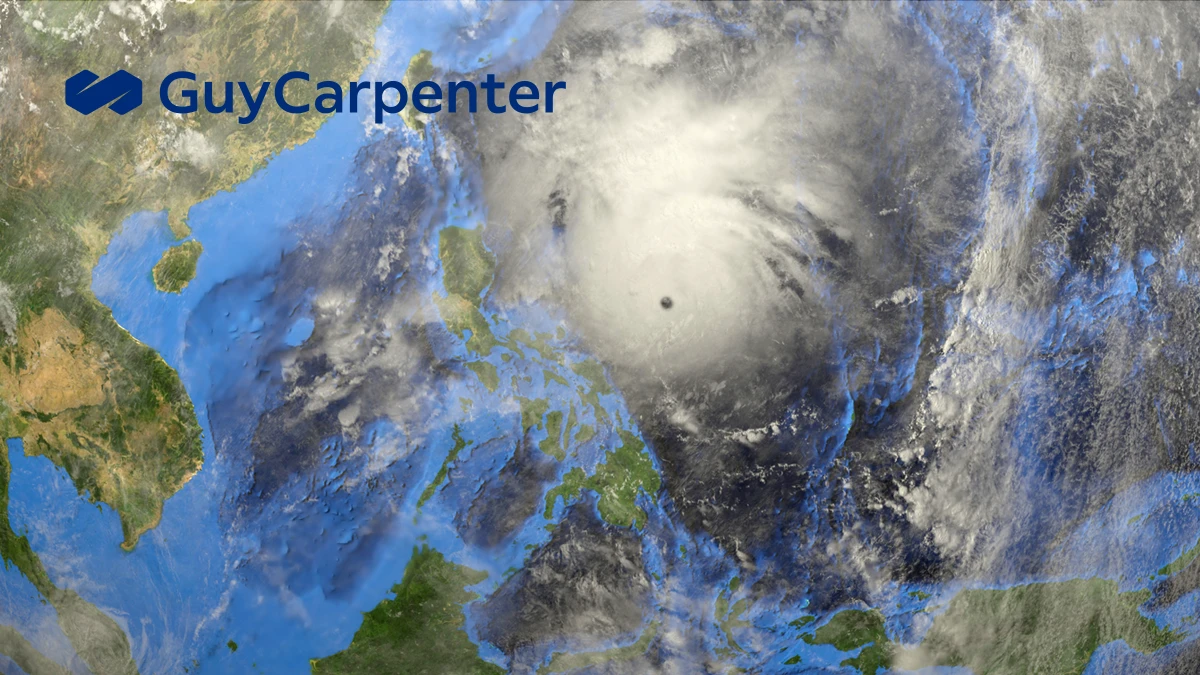Executive Summary
• The El Niño–Southern Oscillation is a major driver of oceanic and seasonal patterns. In El Niño years, we typically see more tropical cyclone activity in the Western North Pacific, while in La Niña years there tends to be lower activity.
• The El Niño conditions that began in 2023 are about to end, with 2024 likely to be a transition to a La Niña year.
• Based on a machine learning model that Guy Carpenter co-developed and past observations, we expect the number of tropical cyclones formations in the Western North Pacific will likely be near-normal.
• The number of landfalls across East Asia will likely be above-normal, except for Eastern Mainland China and Taiwan, where the number of tropical cyclone landfalls is predicted to be near-normal.
The Guy Carpenter GCAT Climate Centre Forecast
For more than 10 years, Guy Carpenter has been working closely with our academic partners in Hong Kong and China via the Guy Carpenter GCAT Climate Centre. Our goal is to provide insights regarding climate-related science for our clients and to help innovate solutions for the increasingly complex risk landscape in Asia.
As part of our ongoing commitment, we produce an annual tropical cyclone seasonal forecast that takes into account current El Niño/La Niña conditions (known as the El Niño Southern Oscillation, or ENSO) and provides insight into tropical cyclone frequency and landfall rates for the Western North Pacific (WNP) basin.
The tropical cyclone forecast is made for the four regions listed below and shown in Figure 1:
• JK: Japan and the Korean peninsula.
• EC: Eastern Mainland China and Taiwan.
• SC: Southern Mainland China and Vietnam.
• PH: Philippines.
Our forecast methodology
Through our partnership with Fudan University in Shanghai, China, our approach is based on the 2022 and 2023 studies by Ye Tian, Wen Zhou and others¹ from Fudan University. They showed that global ocean circulation, especially in the Eastern Pacific, during the Northern Hemisphere winter (December to February) plays a key role in modulating the following year’s tropical cyclone activity in WNP. Here, we utilised machine learning techniques to predict tropical cyclone activity based on the Extended Reconstructed Sea Surface Temperature from the US National Centers for Environmental Information.
The machine learning model uses the random forest algorithm and is trained by both Japanese and American WNP tropical cyclone datasets to create an ensemble. The model is able to fit past tropical cyclone activity with a correlation coefficient of 0.92.
Tropical cyclone data
Tropical cyclone data from the Japan Meteorological Agency (JMA), the Regional Specialized Meteorological Centre delegated by the World Meteorological Organization, is used to analyse historical tropical cyclone activity in the basin.
Climate normal
It is important to compare individual seasons to the climatological normal. Normal is defined as the long-term mean of the most recent 30-year period finishing in a year ending with zero, i.e. conditions in 2024 are compared to the period of 1991-2020. A value is considered as above- or below-normal if it falls within the 10 highest/lowest years of the same 30-year period. It is near-normal if it does not belong to above- or below-normal.
Review of the 2023 typhoon season
Tropical cyclones in a typical El Niño year are more active in WNP but less elsewhere. Despite 2023 being a transition to El Niño year, WNP saw the 4th consecutive year of below-normal tropical cyclone activity. As a result, tropical cyclones in Asia have not contributed significantly to global insured losses (Table 2).
Our 2023 annual tropical cyclone forecast, based on a numerical weather prediction model, matched well with actual landfall activity. Significant typhoons making landfall in the region last year included No. 5 Doksuri (Philippines and Mainland China), No. 7 Lan (Japan) and No. 11 Haikui (Taiwan and Mainland China). Detailed comparison of last year’s forecast and tropical cyclone analysis from JMA are showed in Table 3.
2024 forecast
El Niño–Southern Oscillation
El Niño and La Niña are the 2 opposite phases of El Niño–Southern Oscillation (ENSO). ENSO is an irregular periodic variation in winds and sea surface temperatures over the tropical Pacific, and it is a major driver of seasonal changes in the global atmospheric and oceanic circulations.
Oceanic Niño Index (ONI, Figure 2) is a principal measure for ENSO. It is defined as the 3-month running-mean sea surface temperature (SST) anomalies in the central and eastern tropical Pacific (the Niño 3.4 region in Figure 3). If ONI is -0.5°C or less, then it is in a La Niña phase; Values of +0.5°C or higher signify an El Niño phase. ONI values between -0.5 and +0.5°C are considered as neutral.
A transition to La Niña year
2024 is a transition to La Niña year, shifting from a previous El Niño winter to a predicted La Niña winter.
The current El Niño phase started in the 2023 Northern Hemisphere summer (Figure 2). It peaked in January 2024 and has been decaying since. The Australia Bureau of Meteorology has already declared the end of 2023-24 El Niño, and the US National Oceanic and Atmospheric Administration (NOAA) expects a transition to ENSO-neutral by June. NOAA further predicts more than 80% chance of La Niña from November this year.
Signs of a potential La Niña event are emerging in the Eastern Pacific. Sea surface temperatures along the tropical South America coast have dropped below the climatological mean since March (Figure 3). Under the surface, waters have already become cooler than normal since February. Most climate models predict that ENSO indices in the tropical Pacific are likely to meet La Niña thresholds in the Northern Hemisphere autumn.
A change in ENSO. What does this mean for Western North Pacific tropical cyclone activity?
Typically, tropical cyclones are more active in WNP during El Niño years. They tend to form further away from the East Asia coast and are more likely to recurve toward the seas near Japan. In contrast, during typical La Niña years, there are fewer tropical cyclones. They are more active in the seas west of Guam and more likely to move toward the seas near the Philippines. For this upcoming summer, we may see tropical cyclone activity shifting toward La Niña patterns.
Our machine learning model (ML) predicted the number of tropical cyclones formed during the 2024 season will be 19 to 21, which is near-normal (20.4). Most of the tropical cyclones (17.4, above-normal) are expected to make landfall in East Asia. Tropical cyclone landfalls in SC and PH are predicted to be above-normal. EC is likely to see near-normal landfalling tropical cyclones, while for JK it is expected to be marginally above-normal.
The full model prediction is shown in Figure 4.
Historical seasons during transition to La Niña
To compare the current conditions with relevant historical records, we identified 4 previous transitions to La Niña years (1995, 1998, 2010, 2016) when ONI was in the El Niño phase in March, neutral in June and switched to the La Niña phase by November.
In these 4 transitions to La Niña years, the numbers of tropical cyclones varied between 11 to 22, and 2 of the years were well below-normal. The number of tropical cyclone landfalls were often below-normal, too.
Across the regions of East Asia, the JK region often experienced below-normal tropical cyclone landfalls, while in the PH region, no below-normal year was recorded. For the EC and SC regions, no distinctive pattern can be identified (Figure 5).
While the past observations can be seen as a reference of what to expect for 2024, these characteristics are not guaranteed because each ENSO event is unique, and our model prediction also has some deviations from these 4 years. Nevertheless, it is fair to expect above-normal activity for this year, in particular for the southern regions.
How Guy Carpenter can help
Companies looking to respond faster to catastrophe events, underwrite more profitably and create robust portfolio management strategies can leverage the power of GC AdvantagePoint™, our geospatial analytics and exposure management platform.
The platform enables users to be more proactive in their event response protocols, allowing them to offer a better claims experience to policyholders, improve their loss control, reduce loss adjustment expenses (LAE) and engage reinsurance markets faster.
The underwriting offering brings actionable risk information into a single app and API service suite, enabling carriers to improve their risk selection and underwrite more consistently and profitably. The platform’s advanced technologies and geospatial data analytics enable companies to own their view of risk, unlocking insights to better manage their exposure and grow their portfolios profitably. Please reach out to the contacts on this page for more information, or your local Guy Carpenter team.
Jeremy Waite
Asia Pacific Catastrophe Advisory Group Lead
Jeremy.Waite@guycarp.com
+852 2582 3506
Mark Weatherhead
Head of Global Analytics and Advisory, Southeast Asia and Korea
Mark.Weatherhead@guycarp.com
+65 8380 2989
Karl Jones
Head of Global Analytics and Advisory, Asia Pacific
Karl.Jones@guycarp.com
+61 439 715 896
Charlie Lok
Tropical Cyclone Catastrophe Model Developer
Charlie.Lok@guycarp.com
+61 428 569 330
[1] Tian, Ye, W. Zhou, and W. K. Wong, 2022: Detecting Interdecadal Change in Western North Pacific Tropical Cyclone Genesis Based on Cluster Analysis Using PHash + Kmeans. Frontiers in Earth Science, 9, 825835. https://doi.org/10.3389/feart.2021.825835
Tian, Y., W. Zhou, L. Zhang, Y. Zhang, and R. Zhang, 2023: Changes in ENSO Modulation of the Distribution of Rapidly Intensifying Tropical Cyclones over the Western North Pacific in Boreal Autumn. Journal of Climate, 36, 7739–7753, https://doi.org/10.1175/JCLI-D-23-0084.1












